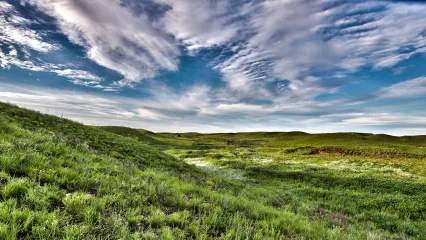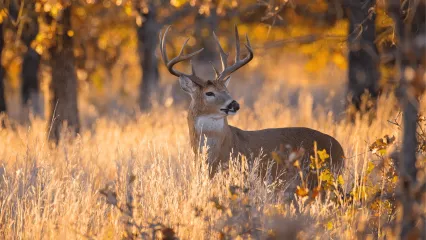
Contacts
Ellis County WMA covers 4,800 acres and is located in Ellis County, 8 miles west and 3.5 miles south of Arnett. Located in the mixed grass prairie, it is a mixture of rolling sand hill uplands and wooded creek bottomland.
Upland sites are vegetated with mixed grass species including big bluestem, indian grass, little bluestem, side-oats grama, and buffalo grass and brush species like shinnery oak, sagebrush, sand plum and black locust. Creek bottoms are dominated by cottonwood, elm, and hackberry trees. Lake Vincent, a 160 acre watershed lake, and two intermittent streams with beaver ponds are located within the boundary. The average annual precipitation for the area is about 24 inches.
Going Quail Hunting?
During quail hunting season, wing collection boxes are placed at several wildlife management areas: Beaver River, Optima, Packsaddle, Cooper, Kaw, Drummond Flats, Canton, Fort Supply, Cross Timbers, and Pushmataha. Hunters are asked to donate a wing from each quail they harvest for research purposes. Ultimately, the wings can help determine the status of the quail populations at the WMAs and can offer clues about how next year’s season might pan out.
From Arnett: 8 miles west on U.S. Hwy 60, 3¾ miles south on N1730.
- Quail: Bobwhite quail are usually present in good numbers but highly sought after.
- Deer: White-tailed deer are usually present in fair numbers.
- Turkey: Rio Grande wild turkey are present in fair numbers.
- Rabbit: Mostly cottontails, but an occasional jackrabbit may be found.
- Furbearers: Coyote, bobcat and raccoon are available.
- Dove: Dove may be present in good numbers during peak migration.
- Waterfowl: Few present, limited to Lake Vincent and ponds.
- Bald Eagle: Occasionally winter at the lake.
Management efforts focus on producing native cover plants and wildlife foods such as ragweed and sunflower, although some small agricultural food plots are planted annually.
Six designated primitive camping areas are located on the area. Both lodging and restaurants are available in Arnett. No shooting range is available.
Fishing opportunities exist at the lake and several small ponds on the area.
Closed Seasons
Same As Statewide Seasons
Seasons w/ Special Restrictions
- Deer Gun
Open during the first nine days only. Antlerless hunting permitted last two days of area season.
- Snipe, Woodcock, Waterfowl, Sandhill Cranes, Rail, Gallinule, Rabbit, Squirrel, Pursuit with Hounds for Furbearers, Predator/Furbearer Calling
Closed during the first nine days of deer gun season.
- Trapping
Open to water sets, live box traps and enclosed trigger traps only through Jan 31. Open same as statewide Feb 1 through end of February.
- Turkey Spring, Youth Turkey Spring
Hunting hours close at 7:00 p.m. daily. One-tom limit; seasons combined.
- Quail
Closed during the first nine days of deer gun season. Closed to non-resident hunting February 1-15.
Hunter and angler camping is allowed in designated areas.
Controlled Hunts: Yet More Ways to Up Your Odds
Additional features continue to be added to the Wildlife Department’s controlled hunts program.
Cackling Geese Tracked in Central Flyway Study
Researchers are tracking cackling geese wintering in a five-state study area to learn more about their movements and habitat preferences.
Study Focused on Bats and Disease-causing Fungus
Bat surveys were conducted to learn more about Oklahoma’s bat communities and hundreds of bats were swabbed for the fungus that causes white-nose syndrome.


